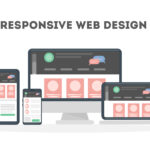The e-commerce website design is an essential component of any company that operates on the Internet. With so much fierce competition in the world of online commerce, having an aesthetically pleasing and accessible e-commerce website design can be an important asset for small-scale enterprises. Logo ideas for small businesses are critical in this design process because they are capable of making a brand’s online identity a hit or flop. A logo is the visual representation of a company and is frequently the very initial thing that an interested consumer discovers about a business. Including logo ideas for small businesses in an e-commerce website design can allow startups to outshine the competition by creating a unified and competent appearance. The e-commerce website design is expected to not only be visually appealing but also functional and simple to use. Startups can establish an impressive digital footprint and bring in a wider demographic by combining logo ideas for small businesses and e-commerce website design.
Short Guide to E-Commerce Website Design
As explained above how dynamic e-commerce website design and logo ideas for small businesses go hand in hand with the design process. It’s time to move on to the details and knowledge you need to gain to achieve a comprehensive and striking web presence for your e-commerce start-up. Here’s a step-by-step walkthrough:
- Determine the Brand Identity
Brand identity is the unique personality and values of a business that sets it apart from competitors in the market. It is the image and perception that customers and potential customers associate with the business. Understanding the brand identity is crucial before coming up with logo ideas for small businesses or developing an e-commerce website design, as it helps to determine the tone, messaging, and design elements that will be used to convey the brand’s personality and values. Questions such as what the business is all about, who the target audience is, and the values that the business stands for are critical to understanding the brand identity. Once these questions are answered, the e-commerce website design elements can be chosen to accurately represent the brand’s identity and effectively communicate with the target audience. Ultimately, a strong brand identity helps to build trust with customers and can lead to increased loyalty and sales.
- Create a Logo That Represents the Brand
A logo is a visual representation of a business’s brand identity. It should be simple, memorable, and visually appealing so that it can leave a lasting impression on customers and potential customers. The logo ideas for small businesses should convey the essence of the business and differentiate it from competitors in the market. Once a logo is created, its colors, fonts, and style can be used to inform the e-commerce website design. The logo’s colors and fonts can be incorporated into the e-commerce website design to create a cohesive brand image. The style of the logo can also inform the website design in terms of the overall aesthetic and design elements used. Consistency between the logo ideas for small businesses and e-commerce website design helps to reinforce the brand identity and create a memorable experience for customers. A well-designed logo can be an effective marketing tool that helps to build brand recognition and customer loyalty over time.
- Choose a Website Platform
Choosing the right website platform is crucial to the success of an e-commerce business. There are various e-commerce platforms available, each with its strengths and weaknesses. Shopify, Woo Commerce, and Magento are popular options that offer a range of features and functionalities. Shopify is a user-friendly platform that is easy to set up and use, making it a great option for businesses with limited technical expertise. Woo Commerce, on the other hand, is a WordPress plugin that is customizable and has a wide range of extensions and integrations available. Magento is a more advanced platform that is suitable for larger businesses with complex e-commerce needs. When choosing a platform for an e-commerce website design, it is important to consider the business’s specific needs and goals, such as the size of the product catalog, the level of customization required, and the budget. It is also essential to ensure that the chosen platform integrates seamlessly with the business’s chosen logo ideas for small businesses and overall brand identity to create a cohesive and memorable user experience.
- Develop a Color Scheme
Developing a color scheme for an e-commerce website design is an important part of creating a cohesive and visually appealing brand identity. One effective way to develop a color scheme is to use the colors from the business’s logo as a starting point. By doing this, the colors used in the e-commerce website design will be consistent with the brand’s overall identity and help to reinforce the brand in the minds of customers. It is important to choose colors that complement each other and create a harmonious and visually pleasing look. For example, if the logo is primarily blue and green, the e-commerce website design could use shades of these colors as the primary color scheme, with a neutral color such as white or gray as a secondary color. Using too many colors can be overwhelming and detract from the entire design, so it’s best to stick to a few colors that work well together. A well-executed color scheme can help to establish a brand’s visual identity and make an e-commerce website design differentiate itself from the competitors.
- Design the Website Layout
The website layout is a crucial aspect of creating a positive user experience for customers. A good layout should be easy to navigate and appealingly showcase the products. Incorporating logo ideas for small businesses and brand colors into the e-commerce website design helps to establish the brand identity and create a consistent look and feel across all pages. The logo can be incorporated into the header of the website, while the brand colors can be used for the background, buttons, and other e-commerce website design components. The footer can also include the logo and other relevant information, such as social media links and contact information. Product pages should be designed to showcase the products in a visually appealing manner, with high-quality images, clear product descriptions, and easy-to-use navigation. It is also important to ensure that the e-commerce website design is mobile-responsive, as an increasing number of customers are accessing e-commerce sites via their mobile devices.
- Ensure the Mobile-Friendliness
In present times where mobile devices have become an integral part of our daily lives, and mobile browsing has surpassed desktop browsing. Therefore, businesses need to ensure that their e-commerce website design is mobile-friendly. This means that the website design should be responsive and adjustable to different screen sizes, whether it’s on a smartphone, tablet, or desktop. A responsive e-commerce website design ensures that the website looks and functions correctly on all devices, providing a positive user experience for all customers. When an e-commerce website design is not mobile-friendly, it can lead to frustration for users, causing them to leave the site and potentially never return. This can lead to a loss of potential customers and revenue for the business. Therefore, it’s a smart choice to invest in a mobile-friendly e-commerce website design to improve user engagement and increase sales.




